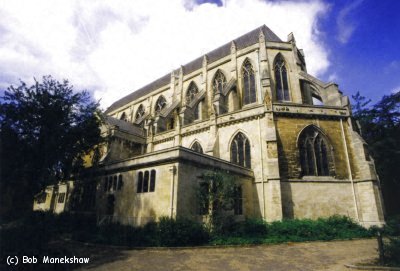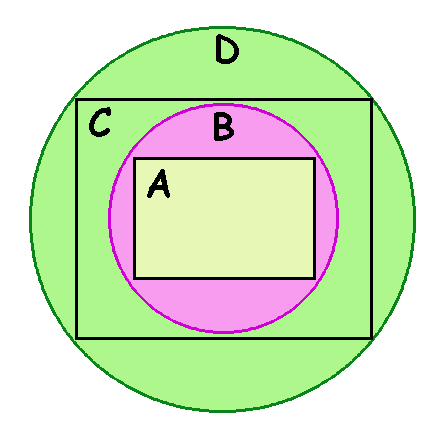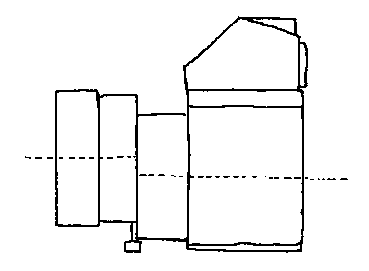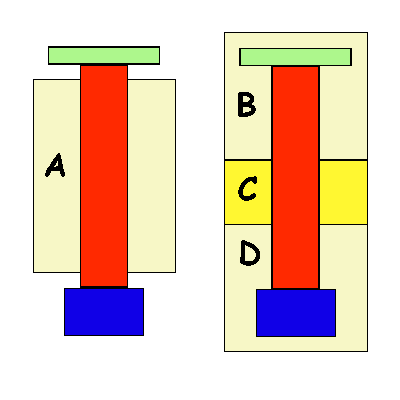 |
Perspective Control (PC) or shift lenses as they are more commenly known, owe their origins to the earliest cameras where the film was seperated from the lens by bellows which allowed them to be moved independantly of each other. This flexibility allows the photographer to correct distortions like converging verticals where the vertical lines of a building appear to converge and recede from the viewer. In order to understand how the lens works, we need to understand the cause of the distortion.
If the camera is placed directly in line with the image and the plane of the film kept parallel with the subject, then the image that will be reproduced will have the same perspective and be distortion free. If, on the other hand, the subject plane is not parallel with the film plane (eg. the camera has to be angled to include all of the subject in the frame) then different parts of the image are reproduced as different sizes - those parts further away from the film will appear smaller than those parts nearer to it. This results in a rectangle object, for example, appearing to narrow towards its top end as the camera is tilted up. This effect is entirely natural - if you imagine railway tracks running away from the camera, the distance between them will appear to lessen the further away they are from the camera - this is the basis of perspective. Sometimes, as in the case of the railway tracks, this convergence of lines in the frame is acceptable and gives the viewer useful information about the distance of each part from the camera. The convergence of lines relating to buildings is not always so acceptable in a picture, particularly vertical lines such as the edges of walls. Fig. 1 shows an example - the vertical sides of the building appear to converge towards the top as the camera is angled upwards. This is a problem, as we know from experience that the sides should be parallel in reality - this makes the picture appear odd, as our brains expect parallel sides to the building, and cannot compensate in the way they do when viewing the building directly.
 |
In order to correct this we need to bring the subject and film planes parallel again, by levelling the camera however doing this may mean that part of the building now falls outside the frame. In order to get the whole building in the frame, we now need to changie viewpoint - for instance, moving up a ladder may be sufficient to enable the camera to be levelled and still get the whole building within the frame. Alternatively, moving to a viewpoint further away from the subject will enable the whole building to fit within the frame, but will mean that the resulting image on the film will be smaller and the resolution and detail will be lost.
The options of raising the camera or moving further back are not always possible, and so another solution is called for. The answer is the shift or perspective control lens which allows the lens to be moved of its axis in one or more directions and has the effect of tilting the camera towards the subject while keeping the film plane parallel with it.
The perspective control lens has two important differences from a normal lens for the same camera. Firstly, the "'covering power"' of the lens is greater i.e. the area of film on which the lens is capable of making an acceptable image. All lenses produce a circular image, and image quality deteriorates to some degree towards the outer edge of this circle. The area of the image where the quality is acceptable is the "'circle of good definition"'. The lens is normally designed, therefore, such that the circle of good definition is just larger than the film frame size. In the case of 35mm film, the negative (24 x 36 mm) has a diagonal of just over 43mm. Therefore the lenses used with 35mm film usually have a circle of good definition of just over 43mm diameter - in this way the deterioration in quality falls outside the negative area. The perspective control lens has a much greater circle of good definition, as can be seen in fig. 2.
 |
A - Normal 35mm Frame B - Normal 35mm lens projection Area C - Theoretical frame size of a shift lens D - Shift lens projection Area |
The second feature of a perspective control lens is its ability to be moved off the axis of the lens mounting (fig. 3) hence the more common name of "'shift"' lens. The movement of the lens allows the photographer to choose which part of the image generated in frame C is placed over the film (frame A) (or, if you prefer, Frame A can be moved around within the coverage area of frame C by shifting the lens of its central axis while keeping the camera still). Increased coverage is therefore essential, to provide a large area of useable image.
 |
To understand this better, consider the following example:
Suppose a picture is being taken of a building using a normal 35 mm format lens. The only available viewpoint is near the building so if the camera is kept level, the hole building will not all appear in the frame. Suppose that a different lens of the same focal length were to be used, one with a greater covering power (larger circle of good definition), such as that from a 6 x 6cm film format camera. From the same point, the whole of the building falls within the 6 x 6cm frame created by the lens with the film plane still parallel with the front of the building. The lens has a larger circle of good definition, which allows the 6 x 6cm negative to be exposed - this would, however, have large areas of unnecessary information on it (there would be a lot of ground), which would be cropped out in the final enlargement. The actual area of interest is the top two thirds which has the building on it and which happens to occupy an area just smaller than 24 x 36mm. If a 35 mm negative (24 x 36 mm in size) could be positioned correctly to receive this image it would do the job equally well. The perspective control lens permits this. Its larger covering power means that the building can be included in the circle of good definition whilst maintaining the film and subject planes parallel. Its ability to be shifted relative to the camera allows the camera to be moved to cover the desired part of the image. In practical terms, once the camera is set to approximately the right position, the lens is moved on the front of it. Although this changes the viewpoint very slightly, this will not normally be a problem. If working at the limit of the lens' view, it may be necessary to reposition the camera slightly and then make final adjustments by moving the lens.
 |
Perspective control lenses are generally wide angle (focal lengths around 28 - 35mm), as they are usually used in circumstances where viewpoints are limited and so a wide angle of view is needed to provide the required coverage of the scene. The lenses are constructed in the manner shown in fig. 5.
|
The rear part of the lens attaches to the camera in the normal way. Moving forward, the next portion of the lens is a rotating ring. This enables the forward part of the lens to rotate relative to the rear (and therefore the camera) so that the shift can take place in any direction. Then, ahead of this is a geared drive knob, which, when turned, shifts the front portion of the lens off from the centre axis. The adjustment of the rotating ring determines in which direction this movement takes place. The maximum shift is normally around 10 - 15mm. Although this doesn't sound much, it must be remembered that the 35mm negative is only 24 x 36mm in size. Therefore, if one picture were taken with 15mm upwards shift and one with 15mm downward shift, only 6mm of the negatives would be overlapping picture information, fig. 6.
 |
A - Normal frame taken by shift lens with no shift B & C - Normal frame with lens fully shifted up C & D - Normal frame with lens fully shifted down C - frame overlap between lens shifted up and lens shifted down Note - If the image doesnt fit the frame, shifting the lens will only alter which part of the image is captured |
Although the perspective correction lens "corrects" the perspective, there is still a form of distortion when using it. When the lens is used to compensate for converging verticals, the upper parts of the building appear vertically stretched (eg. upper stories appear taller) when compared to the uncorrected image. The distortion of convergence has been replaced with the distortion of stretching. This form of distortion is more acceptable to the eye in many cases than converging verticals, and it is often less noticeable.
The perspective correction lens provides a very versatile tool for dealing with difficult picture taking circumstances and providing more "natural" looking images. They are, however, very expensive with a typical price tag of around £1500. This tends to limit their use to professionals and very serious amateurs only.
Their high cost is a result of several factors:
the need for better optical quality than a normal lens for the format in order to give increased coverage by the lens.
the special shift mechanism.
the limited market for such lenses (which is presumably further limited by their high cost).
Nonetheless, they are a very important tool for architectural photography with 35mm format cameras.
Appendix A - Architectural Photography Article
Appendix B - Portfolio - Architectural Heritage of Kingston
Appendix C - Portfolio - Images of England - A Photographers Experience
Appendix D - 1999 Images of England Project
Appendix E - Images of England Web Page